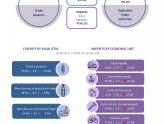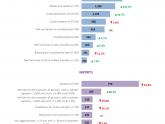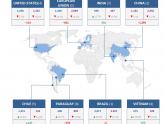Friday, 19 April 2024
In the first three months of 2024, exports totalled USD 17.3 billion (9.0% y-o-y- growth), while imports reached USD 13.1 billion (24.2% y-o-y fall). Thus, the trade balance recorded a surplus of USD 4.3 billion.
Highlights:
- In the January-March 2024 period, exports reached USD 17.3 billion, which represents a 9.0% year-on-year increase, explained by a 18.6% rise in the quantities exported that exceeded the 6.8% drop in prices.
- Imports amounted to USD 13.1 billion and fell 24.2% in year-on-year terms, resulting from drops of 5.4% in prices and 19.9% in quantities imported. This is mainly due to lower prices of intermediate goods, fuels and lubricants, and a decrease in imported quantities of fuels and lubricants, and, to a lesser extent, of parts and accessories for capital goods. Conversely, imports of motor vehicles rose, due to an increase in quantities that exceeded the fall in prices.
- Consequently, the trade balance reached a surplus of USD 4.3 billion, when in the first quarter of 2023 a deficit of USD 1.3 billion had been recorded.

- The increases in wheat exports (USD 972 million, mainly to Indonesia and Brazil), soybean flour and pellets (USD 447 million), crude petroleum oils (USD 352 million) and maize (USD 214 million) stand out; while the largest drops occurred in natural gas in gaseous state (−USD 95 million), unrefined silver (−USD 85 million) and peanuts (−USD 70 million). Although with lower absolute growth, the higher sales of boneless beef, frozen, fresh or refrigerated, stand out.
- In relation to the soybean complex, the prices of crude oil (−29.2%), beans (−33.4%) and flour and pellets (−29.2%) decreased. As for the quantities exported, falls were recorded in those of beans (−34.6%), flour and pellets (−49.8%), and crude oil (−38.7%).
- Regarding imports, the most significant falls occurred in the purchases of diesel oil (−USD 638 million), soybeans (−USD 330 million), gasoline, excluded that for aviation (−USD 160 million) and iron or steel tubes used in oil and gas pipelines (−USD 148 million); while those of vehicles for the transport of persons with a cylinder capacity >1500 cm3 and <=3000 cm3 (USD 118 million) grew.

- The main export destinations were Brazil, with a 17.8% share, the EU, 8.3%, Chile, 7.7%, the United States 7.1%. In turn, the most prominent sources of imports were: Brazil, 23.1%, China, 18.8%, the EU, 16.1%, and the United States, 10.3%.
- The largest surpluses were obtained in trade with Chile (USD 1.2 billion), Peru (USD 661 million), Vietnam (USD 575 million), Indonesia (USD 499 million), India (USD 431 million) and Algeria (USD 329 million); while the main deficits were recorded with China (−USD 1.3 billion), Paraguay (−USD 576 million) and Germany (−USD 442 million).

Related documents:





